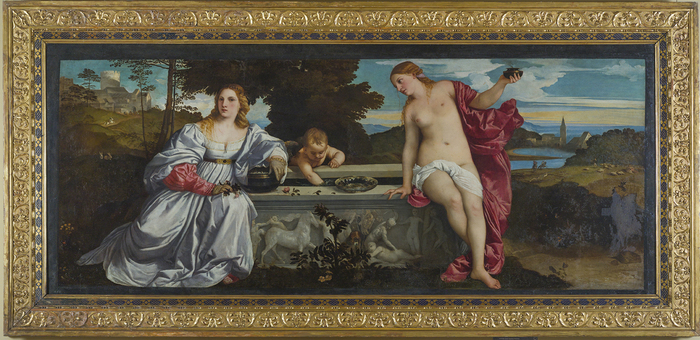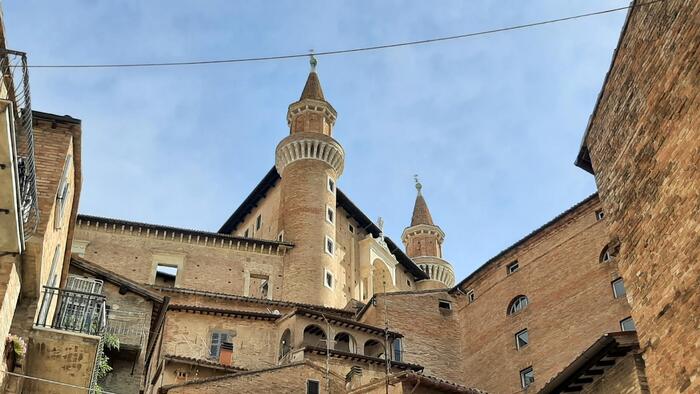Our Lady is more than half a millennium old and extremely sensitive. She doesn't really like changes. Nevertheless, she had to travel again. "Madonna with the Carnations" is the name of the oil painting by Renaissance master Raphael, and shortly before the 500th anniversary of his death in the coming year the work left the National Gallery in London and went to Berlin by truck. A restorer stood by the icon on this tour for days.
The "Madonna with the Carnations" was purchased by the National Gallery London fifteen years ago from the Duke of Northumberland for £ 34m, and has not left England since. Now she is in Berlin. It is an outstanding work by Raphael, who, with his contemporaries Leonardo and Michelangelo, forms the most important trio of the Italian Renaissance. Until the 19th century, Raphael was generally regarded as the world's best, "divine" painter.
At the beginning of his career, Raphael mainly painted Madonna paintings, which were very popular in the early 16th century and made him famous. He painted them spectacularly, in ever new poses, sizes and formats, always striving to improve themselves and to outperform the competition Michelangelo.
The yew wood panel with the carnation Madonna from 1507 is a small picture, about 18 by 22 cm in size. Then a young Maria plays with the baby Jesus on her lap and hands him red carnations - they symbolize bloody nails, Raphael alludes to the suffering of Christ. A German ambassador in Rome almost bought this Madonna 200 years ago, but it went through the rags of the Berlin museums.
Sensor reports temperature fluctuations
Borrowing paintings of such a caliber is very challenging. It starts with the inquiries: While curators and museum directors want to decorate themselves with extensive exhibitions and are interested in high visitor numbers, they have opponents in the museums: the guild of restorers, which is sometimes called "exhibition inhibitor". Your job is to ensure that the cultural treasures are in the best possible condition - in cases of doubt, this sometimes means that no one can see the works.
photo gallery
7 pictures
Photo gallery: The Madonna of the MasterLoans like those of the Carnation Madonna are monitored by restorers and paramedics for a patient transport. A Raphael must neither freeze nor sweat in the truck, and vibrations would have an even greater effect than temperature fluctuations. In order to ensure an even air temperature of 21 degrees and 50 to 55 percent humidity during the journey, the freight forwarder packs the sensitive wood airtight in foil and glass. A sensor in the cargo area reports fluctuations directly to the restorer in the driver's cabin.
Until the nineties, wooden panels were practically never lent. Large museums today also exchange very old paintings. Can you make money with it? Hardly, says Michael Eissenhauer, general director of the Berlin museums. "The big houses in Europe do not charge each other fees. We rely on solidarity." Every rental is a sign of trust to colleagues. In return for the Carnation Madonna, Eissenhauer will give Raphael's "Madonna Terranuova" from 1505, a round clay format of 88 centimeters in diameter, an attraction next spring.
Owner demands longer dowels
Eissenhauer is enthroned over some of these crowd-pullers, he is responsible for 19 houses and 15 collections of the Berlin museum landscape. But the number of visitors is declining. The cultural budget has little budget for day-to-day operations, and the Gemäldegalerie will soon disappear behind the construction site for the Museum der Moderne. The rental of icons is risky and tedious - but a way out of the stagnating business. Eissenhauer hopes for more visitors.
In the Berlin depot, the carnation madonna rested in her white transport box for 24 hours and was not allowed to be moved an inch before a team of five took the multi-million dollar treasure. Two restorers from London and Berlin noted the slightest noticeable thing in the grazing light of their LED lamps: Has something crumbled off the frame? Does the paint layer come up somewhere? Have cracks changed?
There was nothing to complain about. Now Maria smiles gently from the purple wall of the hexagonal cabinet, right next to the "Terranuova", united after 500 years. Before that, however, the exhibition walls had to be thickened so that the painting could be screwed with extra-long dowels. The additional theft protection was the last condition of the English. Better safe than sorry.
Exhibition : "Raphael in Berlin. The Madonnas of the Gemäldegalerie", Gemäldegalerie Kulturforum Berlin, until April 26, 2020








